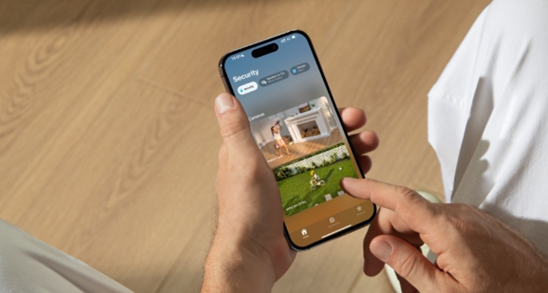Night-vision door cameras are among the characteristics of modern home security systems. These systems let homeowners monitor their property at night, bringing peace of mind. These cameras’ built-in infrared technology allows them to identify intruders and record guests. Night-vision cameras integrate with smart home devices to deliver real-time footage to your smartphone. This post will go over the features, benefits, and installation of various cameras to help you decide which one is best for your home.

Why Choose a Night-Vision Door Camera?
Enhanced Security with Clear Vision
Night-vision entrance cameras provide increased security by maintaining visibility at all times. Regardless of lighting conditions, these cameras employ infrared technology to capture great images even in complete darkness. This feature enables homeowners to notice guests or possible intruders without being hampered by inadequate illumination. These cameras provide more dependable monitoring by allowing them to see effectively at night, preventing thieves from exploiting blind areas. As a consequence, they considerably boost home security by providing 24-hour protection.
Best for Low-Light Environments
Traditional cameras struggle in low-light areas, while night-vision door cameras flourish. These gadgets use infrared technology to capture high-quality photographs and video even in low-light conditions, guaranteeing that no detail is missed. This makes them especially effective in urban environments or locations with low street illumination, where traditional cameras may fail. Whether it’s dusk, morning, or a moonless night, a night-vision door camera gives clarity in every circumstance, letting you see what’s going on around your home at all times.
How Night-Vision Improves Surveillance
Night vision improves surveillance by allowing cameras to record detailed pictures in low- and no-light environments. This function allows homeowners to monitor their premises 24 hours a day, seven days a week, providing constant protection from possible dangers. Surveillance becomes increasingly effective as thieves take advantage of low-light circumstances; however, with infrared technology, night-vision cameras prevent these attempts. Night-vision technology, by delivering clear, useable film in the dark, guarantees that any suspicious behavior is noticed and recorded for future reference.
Key Features to Look for in Night-Vision Door Cameras
Camera Resolution and Image Quality
Resolution is essential for getting sharp photos when choosing a night-vision door camera. Sharper, more detailed film from cameras with higher resolution makes it simpler to identify people or objects in the field of view. For adequate image quality, especially while focusing on fine details, look for cameras with a minimum resolution of 1080p. A high-quality camera also provides better clarity in both day and night conditions, ensuring your security camera delivers accurate and usable footage at all times.
Motion Detection and Alerts
Motion detection is an important function in night-vision door cameras. These cameras include sensors that detect movement within their range and provide an alert to homeowners if any activity occurs. Receiving real-time warnings, whether via smartphone or email, enables you to respond promptly to any dangers. Night-vision door cameras with motion detection can monitor activities even while you are not actively viewing the film, providing you more peace of mind about your home’s security.
Two-Way Audio and Video
Many current night-vision door cameras include two-way voice and video capabilities. This function enables you to talk directly with visitors via the camera, whether they are delivering an item or you are confirming a visitor’s identification. In addition, you may listen to what’s going on outside your door in real time, providing you with a comprehensive picture of the scenario. This interactive capability improves the security of your house, allowing you to deal with crises remotely and without having to open the door.

How to Install a Night-Vision Door Camera
Choosing the Right Location
Positioning your night vision door camera is critical for optimal performance. The camera should be positioned high enough to record the front entrance, porch, and pathway. Place the camera in a protected area to keep it out of the elements while yet providing a nice view. Avoid trees and other objects that may block the camera’s vision. A well-positioned camera provides better coverage and sharper footage, enhancing security.
Wiring and Power Considerations
Night vision door cameras require wired or wireless power. Wired cameras should be placed near a power source or outlet to avoid lengthy extension lines. To upload data from a wireless camera, you will need a good Wi-Fi connection. Keep an eye on the camera’s battery life to prevent having to charge it frequently or experiencing power shortages. Power arrangement is required for continuous observation, especially on critical occasions.
Connecting the Camera to Your Smartphone
Connecting a night-vision door camera to your smartphone is a straightforward operation, usually accomplished using a mobile app provided by the camera manufacturer. After mounting the camera and turning it on, follow the app’s instructions to connect it to your home Wi-Fi network. Once connected, you can see live video, get alerts, and operate the camera using your smartphone, giving you complete remote control. This seamless connection makes it easier to monitor your property from any location, ensuring that you are always aware of what is going on around your house.
Conclusion
Night-vision door cameras are a practical and dependable way to monitor your property, offering increased security throughout both day and night. You may dramatically increase the security of your house by selecting a camera with the appropriate features, such as high resolution, motion detection, and two-way audio. The installation is simple, and with the option to link to your smartphone, monitoring your house has never been easier. A night-vision door camera is a crucial tool for modern home security, whether it’s used to identify burglars or to keep track of deliveries.

